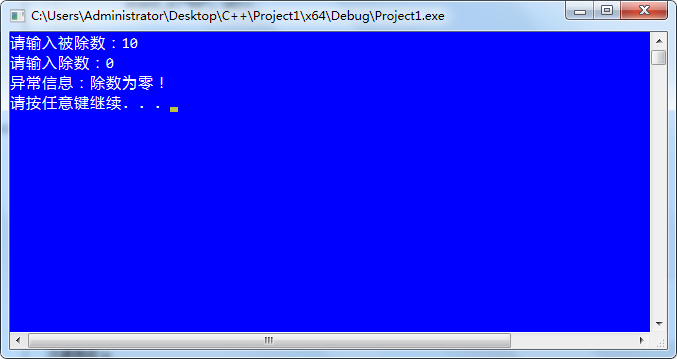异常
#include <iostream>
using namespace std;
double division(int a, int b)
{
if (b == 0)
{
throw "除数为零!"; // 一旦满足出现异常的条件就抛出异常
}
return a / b;
}
// 程序的主函数
int main()
{
int a, b;
double result;
printf("请输入被除数:");
scanf_s("%d", &a);
printf("请输入除数:");
scanf_s("%d", &b);
try
{
result = division(a, b); // try中的代码是受保护的代码块,即是受监视的代码块,一旦出现异常将会被catch住
cout << "result = " << result << endl;
}
catch (const char * msg) // 将异常信息赋值到msg变量进行输出
{
cerr << "异常信息:" << msg << endl;
}
system("pause");
return 0;
}
运行:

#include <iostream>
#include <exception>
using namespace std;
// 继承 exception 异常类
struct MyException : public exception
{
// what() 是 exception 异常类的方法, throw() 是异常规格说明,目的是告诉调用这个方法的人会出现哪些异常,没有参数表示可能出现各种异常
const char * what() const throw()
{
return "C++ Exception.";
}
};
int main()
{
try
{
throw MyException(); // 抛出一个异常
}
catch (MyException &e) // e 是 Myexception 自定义异常类的对象,即 exception 异常类的对象,可调用 what() 方法获取异常信息
{
cout << "MyException Caught:" << endl;
cout << e.what() << endl;
}
catch (std::exception &e)
{
// 除了上面的异常之外的其他的异常
}
system("pause");
return 0;
}







 浙公网安备 33010602011771号
浙公网安备 33010602011771号